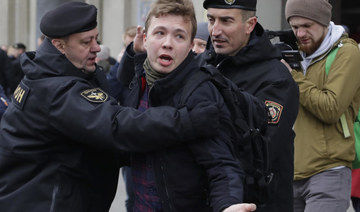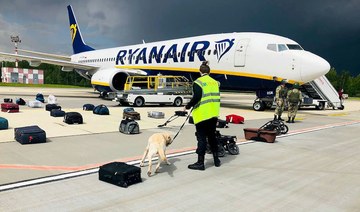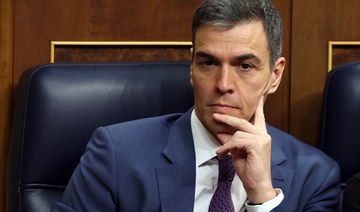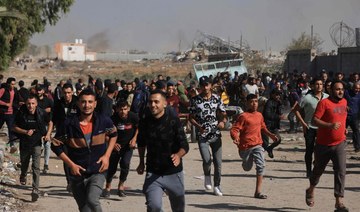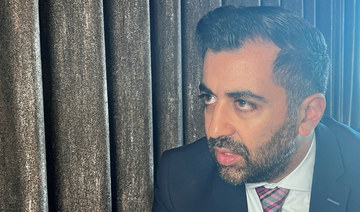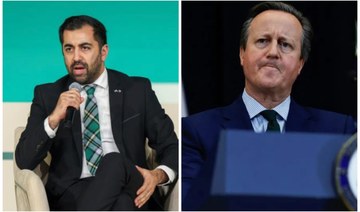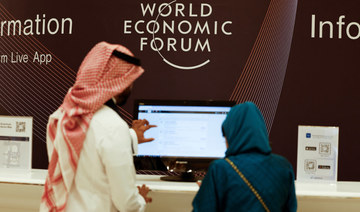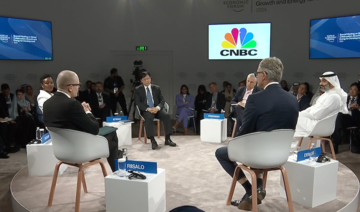MINSK: A defiant President Alexander Lukashenko on Wednesday defended Belarus’s diversion of a European flight and arrest of a dissident on board, lashing out at critics at home and abroad.
In his first public statement since the Ryanair flight was diverted and opposition journalist Roman Protasevich arrested on Sunday, Lukashenko dismissed the international outcry the incident provoked.
“I acted lawfully to protect our people,” Lukashenko said in an address to parliament, the Belta state-run news agency reported.
The criticism was nothing more than another attempt by his opponents to undermine his rule, he said, accusing them of waging a “modern, hybrid-war” against Belarus.
“Our ill-wishers at home and abroad have changed their methods of attacking the state,” Lukashenko said, accusing them of crossing “red lines” and “boundaries of common sense and human morality.”
“They have moved from organizing riots to strangulation.”
Lukashenko — often dubbed “Europe’s last dictator” — is facing some of the strongest international pressure of his nearly 27-year rule of ex-Soviet Belarus.
The strongman and his allies are already under a series of Western sanctions over a brutal crackdown on mass protests that followed his disputed re-election to a sixth term last August.
European leaders are now accusing authorities in Minsk of essentially hijacking the passenger flight, and they agreed this week to cut air links with Belarus and told airliners to avoid the country’s airspace.
The Belarusian opposition has called for further and stronger measures, and the UN Security Council was set to meet behind closed doors later on Wednesday.
The Athens-to-Vilnius flight was diverted over a supposed bomb scare, with Lukashenko scrambling a MiG-29 fighter jet to accompany the aircraft.
Belarus has released a transcript of communications between Minsk air traffic control and the Ryanair flight, in which the crew was told “you have a bomb on board” and urged to land in Minsk.
Lukashenko on Wednesday denied that the fighter jet had forced the airliner to land, calling such claims an “absolute lie.”
He claimed that Ukraine, Poland and Lithuania had denied the Ryanair flight permission to land and that the commercial flight’s only option had been to turn to Minsk.
Protasevich — the 26-year-old co-founder of opposition Telegram channel Nexta — and his Russian girlfriend Sofia Sapega were arrested after the plane landed.
Protasevich, who had been living between Poland and Lithuania, appeared in a video on Monday in which he confessed to helping to organize mass unrest, a charge that could land him in jail for 15 years.
Sapega, a 23-year-old law student at the European Humanities University (EHU) in Lithuania, appeared in another video on Tuesday, saying she worked for a Telegram channel that disclosed information about Belarusian police.
Her lawyer said she had been remanded in pre-trial detention for two months and Russia confirmed she was being detained as a criminal suspect.
Belarus’s opposition says such videos are routinely recorded by security forces, with participants forced to make statements under duress.
Protasevich’s mother told AFP in Poland that she had not slept since he was arrested.
“I’m asking, I’m begging, I’m calling on the whole international community to save him,” Natalia Protasevich said, weeping.
“They’re going to kill him in there.”
EU leaders on Monday warned they would adopt further “targeted economic sanctions” against the Belarusian authorities to add to the 88 regime figures and seven companies on a blacklist.
Last year’s protests lasted for months, with tens of thousands taking to the streets to denounce Lukashenko, but were brutally quashed and thousands were detained — many of whom reported torture and abuse in custody.
On Wednesday, dozens of people marched through the streets of Beryozovka east of Minsk for the funeral of Vitold Ashurok, 50, a well-known opposition activist who died Sunday from cardiac arrest in a penal colony in eastern Belarus.
Many protest leaders — including now-exiled opposition leader Svetlana Tikhanovskaya, who claimed victory in the August vote — fled the country, and the demonstrations have dwindled.
Tikhanovskaya this week urged Europe and Washington to take stronger action against Lukashenko’s regime, but the strongman continues to enjoy solid support from Russia.
The Kremlin’s spokesman Dmitry Peskov said Wednesday there was no reason to disbelieve Lukashenko’s version of events and announced a meeting between Russian President Vladimir Putin and the Belarusian leader in Russia on Friday.
Speaking to the European Parliament via video link on Wednesday, Tikhanovskaya called for a series of concrete measures, including a ban on new foreign investments and on Belarus’s main exports like oil and metal products, potash fertilizers and wood.
Diplomatic sources told AFP the UN Security Council would hold an informal meeting on Belarus on Wednesday but was unlikely to agree on a collective statement because of Russia’s support for Minsk.
Defiant Lukashenko defends plane diversion, blasts critics
https://arab.news/w7spk
Defiant Lukashenko defends plane diversion, blasts critics

- Minsk air traffic control informed the crew of the Ryanair Athens-to-Vilnius flight that they had a bomb onboard and urged them to land in the Belarusian capital
- Roman Protasevich — the 26-year-old co-founder of opposition Telegram channel Nexta — and his Russian girlfriend Sofia Sapega were arrested after the plane landed
Iran slams crackdown on US student protesters

“The American government has practically ignored its human rights obligations and respect for the principles of democracy that they profess,” foreign ministry spokesman Nasser Kanani said.
Tehran “does not at all accept the violent police and military behavior aimed at the academic atmosphere and student demands,” he said.
American universities have been rocked by pro-Palestinian demonstrations, triggering campus clashes with police and the arrest of some 275 people over the weekend.
The demonstrations began at Columbia University in New York and have since spread across the country.
In Iran, hundreds of people demonstrated in Tehran and other cities on Sunday in solidarity with the US demonstrations.
Some carried banners proclaiming “Death to Israel” and “Gazans are truly oppressed,” state media reported.
The Gaza war broke out after the October 7 attack by Palestinian militants on Israel which killed 1,170 people, mostly civilians, according to Israeli figures.
Tehran backs Hamas, but has denied any direct involvement in the attack.
Israel’s retaliatory offensive against Hamas has since killed at least 34,488 people in Gaza, mostly women and children, according to the Hamas-run territory’s health ministry.
“What we have seen in American universities in recent days is an awakening of the world community and world public opinion toward the Palestinian issue,” Kanani said.
“It is not possible to silence the loud voices of protesters against this crime and genocide through police action and violent policies.”
Pedro Sanchez stays on as Spain’s prime minister after weighing exit
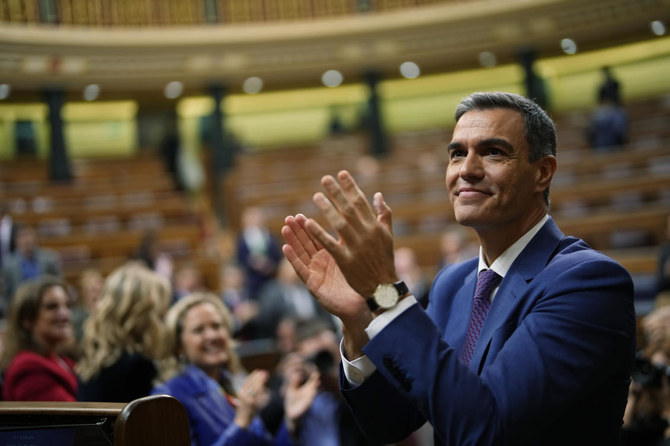
- Sanchez had surprised foes and allies when earlier said he considers quitting
- He described the court investigation of his wife Begona Gomez for influence peddling and business corruption as orchestrated by his opponents
MADRID: Spain’s Prime Minister Pedro Sanchez said on Monday he had decided to continue in office, days after abruptly announcing he was considering his future following the launch of a corruption investigation against his wife.
The center-left prime minister, 52, had surprised foes and allies alike when he said on Wednesday he was taking time from public duty to consider quitting. He described the court investigation of his wife Begona Gomez for influence peddling and business corruption as orchestrated by his opponents.
Sanchez met King Felipe VI on Monday — a step that would have been necessary should he have decided to resign — but announced in a televised address that he had informed the monarch of his decision to stay on. He had been encouraged to stay by widespread expressions of support over the weekend, Sanchez said.
“I have decided to go on, if possible even stronger as prime minister. This is not business as usual, things are going to be different,” he said in a national broadcast.
His announcement that he might quit had caused further turmoil in Spanish politics, where a fractious parliament has struggled to form coalition governments after close elections. Should a new election have been required, it would have been the fourth in five years.
The opposition will try to exploit the sign of indecision from Sanchez, but the impact may be limited because Spain’s political landscape is already so polarized, said Ignacio Jurado, political science professor at Madrid’s Carlos III University.
“His credibility is already hotly contested and voters have already given it to him or taken it away,” he said. “As a leader he has shown a weakness and it’s something that the opposition will exploit a lot.”
Scotland’s Yousaf will resign as first minister, BBC says
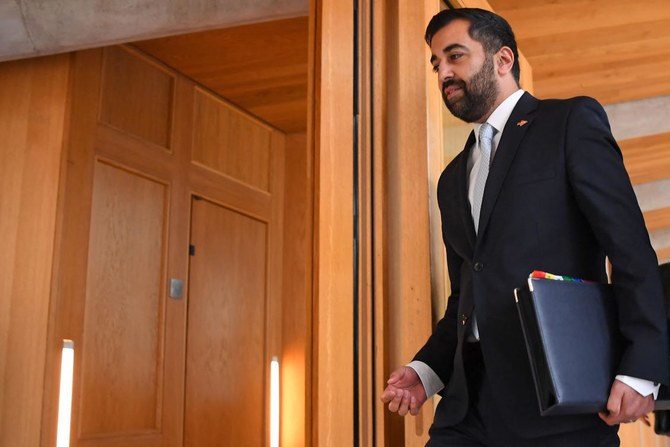
LONDON: Scotland’s first minister Humza Yousaf will resign as early as Monday, the BBC reported, after the possibility of him winning a vote of confidence this week appeared to dwindle over the weekend.
“Scotland’s First Minister Humza Yousaf (is) to resign as early as today, the BBC understands,” BBC News said, without citing a source.
Last week, Yousaf abruptly ended a power-sharing agreement between his Scottish National Party (SNP) and the Green Party, in the hopes that he could lead a minority government — but opposition parties have tabled a vote of no confidence.
The pro-independence SNP’s fortunes have faltered amid a funding scandal and the resignation of a party leader last year, while there has been infighting over how progressive its pitch should be as it seeks to woo back voters.
Just days ago, Yousaf said he was “quite confident” that he could win the no confidence vote called by political opponents, but by Monday, his offer of talks with other parties to try to shore up his minority government seemed to be faltering.
The leadership crisis and a second no-confidence vote against the Scottish government deepens problems faced by Yousaf’s Scottish National Party, which is losing popular support after 17 years of heading the Scottish Government.
Earlier this month, polling firm YouGov said the Labour Party had overtaken the SNP in voting intentions for a Westminster election, for the first time in a decade.
The leader of the Scottish Greens, Patrick Harvie, told BBC radio there was nothing Yousaf could say to persuade his party to support the first minister in the parliamentary confidence vote, leaving Yousaf with few options.
The vote is due to take place later this week.
A victory for Labour in Scotland in Britain’s next national election — expected later this year — would significantly bolster the party’s chances of taking power from Prime Minister Rishi Sunak’s Conservative Party.
If Yousaf loses, parliament would have 28 days to choose a new first minister before an election is forced.
Former SNP leader John Swinney has been approached by senior party figures to become an interim first minister in the event of Yousaf being forced from office, the Times newspaper said, adding that Swinney was reluctant to step up because of personal circumstances.
Yousaf, who previously held health and justice ministerial briefs in the Scottish Government, succeeded former SNP leader Nicola Sturgeon as first minister in March 2023.
She resigned last year and has since been embroiled in a party funding scandal with her husband, who was charged this month with embezzling funds. Both deny wrongdoing.
Global teacher shortage needs more than AI: WEF panelists
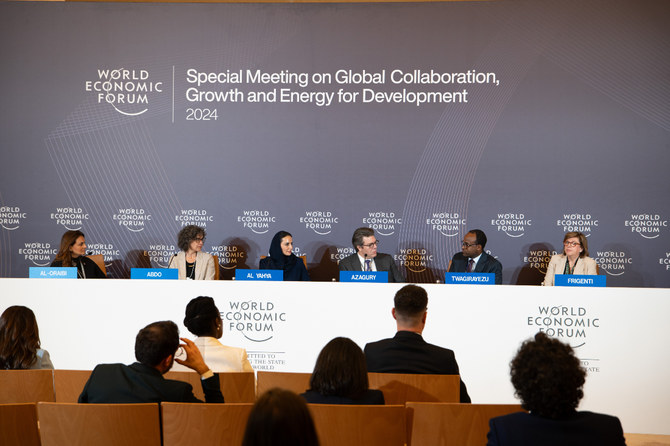
- Tailored solutions required for less-developed nations, says expert
- AI must complement education and training, changing of curricula
RIYADH: The global shortage of teachers will not be remedied solely through the use of artificial intelligence, according to education experts and decision-makers at the World Economic Forum’s Special Meeting in Riyadh.
“Teachers is the biggest problem at the moment for the education sector in low- and middle-income countries,” Laura Frigenti, chief of the Global Partnership for Education platform, told the panel on Sunday.
Gaspard Twagirayezu, Rwanda’s education minister, said that AI can revolutionize education and provide solutions for the global shortage of teachers.
“Of course, AI and technology are not going to replace teachers,” he added. “We can make sure that teachers are properly educated.”
“Here, we are trying to talk about how AI can help in producing education materials for the teachers so that we do not have all these expensive training sessions that we all have to go through.”
Stressing that AI can support teachers in the classroom, Twagirayezu explained that “teachers can be enabled to learn on their own using AI.”
Frigenti said that when it comes to harnessing the power of artificial intelligence in education, “there is not a kind of a one-size-fits-all technology that you can just import into one particular country.”
“You have to start from the conditions of that country and think in terms of a solution,” she continued. If there are no tailored solutions, this would “create a much bigger gap between a part of the world that can invest $8,000 per child per year in education and a part of the world that barely manages to invest $80.”
She added: “And that is going to create all sorts of socio-economic disparities, inequalities within society, (and) inequalities between the Global North and Global South.”
Frigenti added: “We integrate the improvements that technology and AI can add to the way in which the sector performs or is managed to a bigger way of thinking about the sector’s needs to transform, which includes a lot — changing the curricula (and) thinking about what you have to do for the (teachers) problem.”
The panel discussion, titled “Is Education Ready for AI,” featured speakers including Rudayna Abdo, founder and CEO of Thaki; Jack Azagury, group CEO of Accenture; and Deemah Al-Yahya, secretary-general of the Digital Cooperation Organization.
China’s robotic spacecraft headed for moon to carry payload from Pakistan
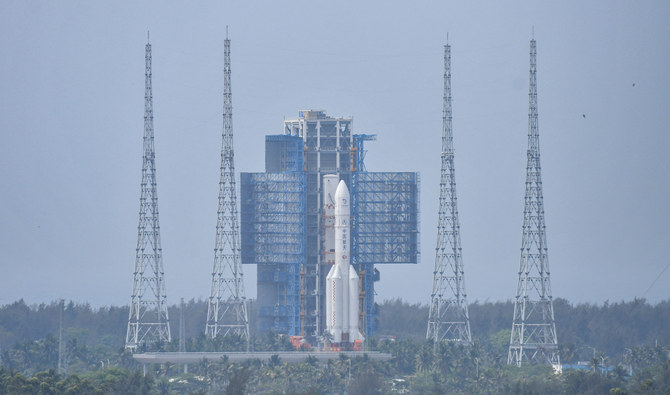
- China will send a robotic spacecraft in coming days on round trip to moon’s far side in first of three missions
- Chang’e-6 spacecraft will carry payloads from countries such as France, Italy, Sweden and Pakistan
BEIJING: China will send a robotic spacecraft in coming days on a round trip to the moon’s far side in the first of three technically demanding missions that will pave the way for an inaugural Chinese crewed landing and a base on the lunar south pole.
Since the first Chang’e mission in 2007, named after the mythical Chinese moon goddess, China has made leaps forward in its lunar exploration, narrowing the technological chasm with the United States and Russia.
In 2020, China brought back samples from the moon’s near side in the first sample retrieval in more than four decades, confirming for the first time it could safely return an uncrewed spacecraft to Earth from the lunar surface.
This week, China is expected to launch Chang’e-6 using the backup spacecraft from the 2020 mission, and collect soil and rocks from the side of the moon that permanently faces away from Earth.
With no direct line of sight with the Earth, Chang’e-6 must rely on a recently deployed relay satellite orbiting the moon during its 53-day mission, including a never-before attempted ascent from the moon’s “hidden” side on its return journey home.
The same relay satellite will support the uncrewed Chang’e-7 and 8 missions in 2026 and 2028, respectively, when China starts to explore the south pole for water and build a rudimentary outpost with Russia. China aims to put its astronauts on the moon by 2030.
Beijing’s polar plans have worried NASA, whose administrator, Bill Nelson, has repeatedly warned that China would claim any water resources as its own. Beijing says it remains committed to cooperation with all nations on building a “shared” future.
On Chang’e-6, China will carry payloads from France, Italy, Sweden and Pakistan, and on Chang’e-7, payloads from Russia, Switzerland and Thailand.
NASA is banned by US law from any collaboration, direct or indirect, with China.
Under the separate NASA-led Artemis program, US astronauts will land near the south pole in 2026, the first humans on the moon since 1972.
“International cooperation is key (to lunar exploration),” Clive Neal, professor of planetary geology at the University of Notre Dame, told Reuters. “It’s just that China and the US aren’t cooperating right now. I hope that will happen.”
SOUTH POLE AMBITIONS
Chang’e 6 will attempt to land on the northeastern side of the vast South Pole-Aitkin Basin, the oldest known impact crater in the solar system.
The southernmost landing ever was carried out in February by IM-1, a joint mission between NASA and the Texas-based private firm Intuitive Machines.
After touchdown at Malapert A, a site near the south pole that was believed to be relatively flat, the spacecraft tilted sharply to one side amid a host of technical problems, reflecting the high-risk nature of lunar landings.
The south pole has been described by scientists as the “golden belt” for lunar exploration.
Polar ice could sustain long-term research bases without relying on expensive resources transported from Earth. India’s Chandrayaan-1 launched in 2008 confirmed the existence of ice inside polar craters.
Chang’e-6’s sample return could also shed more light on the early evolution of the moon and the inner solar system.
The lack of volcanic activity on the moon’s far side means there are more craters not covered by ancient lava flows, preserving materials from the moon’s early formation.
So far, all lunar samples taken by the United States and the former Soviet Union in the 1970s and China in 2020 were from the moon’s near side, where volcanism had been far more active.
Chang’e-6, after a successful landing, will collect about 2 kilograms (4.4 pounds) of samples with a mechanical scoop and a drill.
“If successful, China’s Chang’e-6 mission would be a milestone-making event,” Leonard David, author of “Moon Rush: The New Space Race,” told Reuters. “The robotic reach to the Moon’s far side, and bringing specimens back to Earth, helps fill in the blanks about the still-murky origin of our Moon.”



